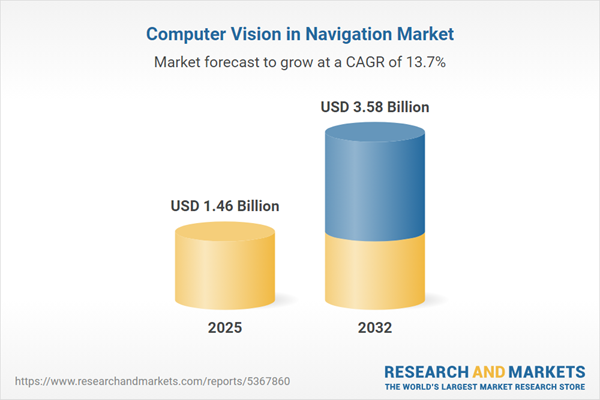Speak directly to the analyst to clarify any post sales queries you may have.
Senior executives are increasingly turning to computer vision navigation to streamline enterprise operations, support automation, and drive continuous resilience amid changing market conditions. Powerful vision-driven navigation systems are advancing efficiency and adaptability, enabling organizations to thrive in dynamic environments.
Market Snapshot: Computer Vision Navigation
The computer vision navigation market reached a value of USD 1.28 billion in 2024, propelled by a compound annual growth rate (CAGR) of 13.70%. This rapid expansion is driven by strong multi-industry demand, with sectors such as automotive, robotics, aerial systems, and maritime operations seeking more accurate and intelligent navigation to improve productivity. Enterprises are leveraging deep learning algorithms, upgraded hardware-software combinations, and innovative interface solutions to address shifting business and operational risks. As reliable automation becomes essential for competitive advantage, logistics and manufacturing leaders are prioritizing computer vision navigation to elevate efficiency, safety, and scalability in challenging operating environments.
Scope & Segmentation: Computer Vision Navigation Market
- Applications: Advanced driver assistance systems, robotics, autonomous operation, augmented reality navigation, indoor and outdoor positioning, aerial drone management, and marine tracking solutions. Each facilitates productivity, enhances workplace safety, and supports agile responses to market demands.
- Components: Camera systems, LiDAR modules, radar technologies, digital mapping platforms, high-performance processors, and perception software all underpin effective automation. These components integrate seamlessly with enterprise systems to elevate functional output.
- Technologies: Enterprises deploy 2D and 3D vision, sensor fusion, and deep learning models to improve object detection and increase adaptability to variable operational scenarios, including automation and real-world environmental complexity.
- Vehicle Types: Commercial fleet vehicles and passenger cars implement vision-driven solutions to optimize routing, streamline operational management, and fulfill corporate objectives for transportation efficiency.
- Deployment Options: Organizations can choose between aftermarket retrofits or OEM-integrated solutions to accelerate new technology adoption, manage compliance, and facilitate ongoing upgrades in line with evolving standards.
- End Use Industries: Aerospace, defense, automotive, industrial manufacturing, and consumer electronics industries use computer vision navigation to scale operations, boost system reliability, and address shifts in competitive landscapes.
- Regions: The Americas, Europe, Middle East, Africa, and Asia-Pacific are principal markets. Countries like China, India, Japan, Australia, and South Korea exhibit robust growth through focused investment in regulation, infrastructure, and innovation.
- Key Companies: Leading market participants include Intel Corporation, Robert Bosch GmbH, Continental AG, Denso Corporation, Aptiv PLC, Valeo SA, Magna International Inc., ZF Friedrichshafen AG, NVIDIA Corporation, and NXP Semiconductors N.V., who collectively drive technological progress and market direction.
Key Takeaways for Senior Decision-Makers
- Strategic partnerships among hardware suppliers, software innovators, and integrators enable agile responses to operational disruptions and evolving manufacturing needs.
- Computer vision navigation adoption in robotics and industrial automation unlocks measurable gains in environments with challenging production or security parameters.
- LiDAR and radar module advancements are enhancing system dependability and helping organizations manage rising complexity and shifting compliance requirements.
- Geographic growth patterns reflect strong links between urban infrastructure developments and targeted investments in diversified manufacturing, driving tailored solutions for local regulations and preferences.
- Modular, upgradable technologies support efficient compliance management and make operational transitions more streamlined across entire product lifecycles.
- Resilient supplier partnerships and region-focused sourcing enhance supply chain flexibility, empowering enterprises to manage regulatory or geopolitical uncertainty more effectively.
Tariff Impact on Computer Vision Navigation
Recent adjustments to tariffs on key technology components are reshaping enterprise sourcing and supply chains. In this environment, deepened supplier collaboration fosters quicker product cycles and greater cost control. Forward-thinking logistics planning helps shield innovation initiatives from disruption and ensures continuity in the computer vision navigation market.
Methodology & Data Sources
This report is informed by comprehensive secondary research, supplemented with insights from interviews with experienced sector professionals. Senior executive perspectives provide additional depth, enabling thorough assessment of market strategies, technology usage, and future directions across all relevant segments.
Why This Computer Vision Navigation Market Report Matters
- Provides segmented market insights across regions and applications to help enterprises develop targeted technology strategies aligned with present market needs.
- Supports effective supply chain planning and regulatory compliance approaches, aiding business leaders in managing change and ensuring operational continuity.
- Enables decision-makers to optimize resource allocation, strengthen partner relationships, and uncover new growth opportunities in established and emerging regions.
Conclusion
This market intelligence equips senior leaders to enhance resilience, manage risk proactively, and set strategic direction in an industry defined by ongoing change and increasing automation.
Additional Product Information:
- Purchase of this report includes 1 year online access with quarterly updates.
- This report can be updated on request. Please contact our Customer Experience team using the Ask a Question widget on our website.
Table of Contents
3. Executive Summary
4. Market Overview
7. Cumulative Impact of Artificial Intelligence 2025
Companies Mentioned
The companies profiled in this Computer Vision in Navigation market report include:- Intel Corporation
- Robert Bosch GmbH
- Continental AG
- Denso Corporation
- Aptiv PLC
- Valeo SA
- Magna International Inc.
- ZF Friedrichshafen AG
- NVIDIA Corporation
- NXP Semiconductors N.V.
Table Information
| Report Attribute | Details |
|---|---|
| No. of Pages | 196 |
| Published | October 2025 |
| Forecast Period | 2025 - 2032 |
| Estimated Market Value ( USD | $ 1.46 Billion |
| Forecasted Market Value ( USD | $ 3.58 Billion |
| Compound Annual Growth Rate | 13.7% |
| Regions Covered | Global |
| No. of Companies Mentioned | 11 |









